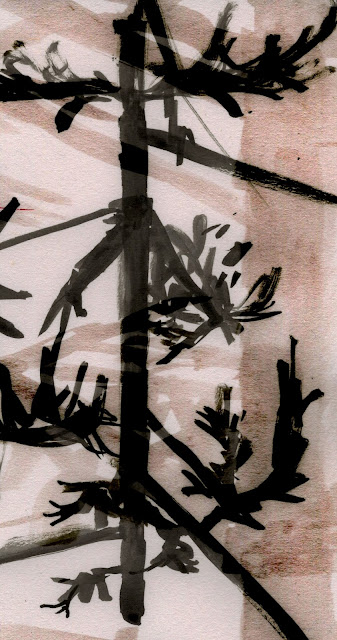Below are some examples of drawings I've done which express this notion, or variations of it, throughout various stages of my thought process, beginning with some from my trip to the 'Yorkshire Sculpture Park' where I first began to think in this way, leading up to a small zine I made once my ideas had solidified somewhat.
 |
| Looking through a gap in bridge, still containing quite a bit of detail and three dimensional depth (YSP). |
 |
| Looking through a Henry Moore, becoming more abstract but still contains identifiable objects such as trees. |
 |
| Looking through a Henry Moore hole, again still identifiable shapes such as a gate. |
 |
| Looking through a Henry Moore hole, the most abstracted drawing so far, the shapes are about as simple as I could have made them. |
I have since been investigating some artists who might have taken similar approaches, or created similar aesthetics within their own work. Firstly, I have been looking at the work of 'Atelier Bingo' (the combined effort of Maxime Prou and Adele Favreau).


Their work is comprised of very bold simple shapes formed from what often appears to be cut paper compositions. I am not sure exactly where they garner inspiration from, I think their approach is in fact highly experimental and does not often necessarily have a specific theme which inspired it. In any case, they definitely seem to be more process driven than conceptually driven.
At the moment I am working predominantly with line drawings but I think it would be extremely beneficial to start working with shapes made from cut paper and starting to consider colour, even if I still just draw to start with. I can see this approach working very effectively in my project as it seems to be becoming more and more shape driven. I will start experimenting with this approach, maybe replicating the same 'view' numerous times using different drawn and collage techniques to identify strengths and weaknesses of each.
Another artist I have looked is Mishka Henner, in particular his book 'Less Americains, inn which he took a classic book of photographs named 'The Americans' by Robert Frank, and erased parts of each photograph to create new, strange and incongruous compositions.

This work is no doubt controversial, Frank's book is one of the most revered photography books of the 20th century and Henner's use of appropriation and erasure has been viewed as insulting and "transparently absurd." I, myself could not be offended by it due to the fact that I did not know about the original book before coming across Henna's appropriation. Rather, I became interested in it because he deals with one of the themes I've have been considering myself - removing contextual information to create these strange abstract compositions. It's interesting how seemingly nonsensical these images become once the information which describes aspects such as depth or size is removed. The relationship between the shapes in the images is altered drastically in such a way as to pose a great challenge to the viewer's brain in trying to connect the seemingly disparate parts, and as a result forming new interpretations of the space.
I would like to experiment with a similar process, using my own photographs, and see if it leads me anywhere interesting.











































